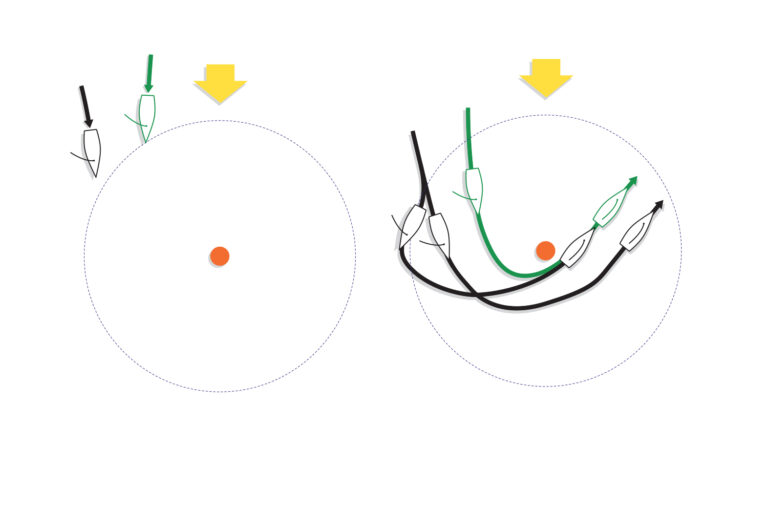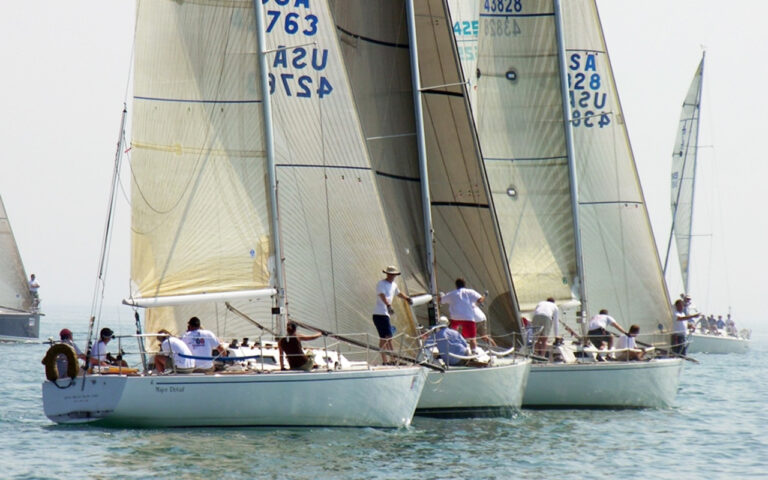
PBOrigging
The weight-saving benefit of high-tech fiber rigging is no secret: the stuff has been used by grand-prix, America’s Cup, and other high-end teams for 10 years. Yet high prices and custom fits have kept it out of the hands of the competitive sailing masses. This is starting to change as advanced production of smaller diameter cable increases, driving down the cost, and termination technology suitable for existing rigs becomes available. For most of us, the wire rigging now supporting our rigs is perfectly suited for our needs: it’s relatively inexpensive and its limits and capabilities are well known. So why make the upgrade to PBO? Two of the big names in the sailing world, West Marine and Navtec, now offer semi-production PBO standing rigging, so we asked them.First, a note about manufacturers of fiber rigging: A three-year collaborative effort between West Marine and Applied Fiber produced the PowerLite system, specifically designed for yacht rigging applications. This system includes the PBO cable and the advanced termination technology and spreader fittings that allow single-strand PBO bundles to be used on existing spars that utilize continuous rigging (discontinuous PBO rigging solutions are under development by West and Applied Fiber). Applied Fiber also develops PBO cable and terminations for the U.S. military, NASA, and the medical, automotive, and timber industries. Navtec started from ground zero back in 1997, assigning engineers in their Connecticut plant the task of figuring out how best to make production PBO rigging. Navtec’s PBO rigging is called the Z-System, with proprietary cables and sockets produced by Lapp Muller, one the world’s largest cable manufacturers. Navtec’s terminations are available for both continuous and discontinuous rigging. Both companies have predicted the future of standing rigging is fiber technology, and are aiming their sights not only on the high end of the sport, but the club racer as well. Other companies, such as New Zealand’s Southern Spars and England’s Future Fibres make aramid and PBO rigging too, but the price tag for their custom rigging, which is continuously wound from one very long fiber filament, is still out of the average sailor’s reach.Sizing Up PBOStanding rigging is normally sized for stiffness, or the stretch per cross-sectional area, which shouldn’t be confused with strength, maximum working load, or minimum breaking load. Sizing for stiffness will yield a PBO cable size that is approximately 50 percent stronger than the equivalent stainless wire or rod, but with a whopping 75 percent reduction in weight. Because of the cable cover, PBO cable has a larger diameter as compared with equivalent stainless wire, but the windage penalty is negligible.While Navtec custom sizes its cable and fittings depending on the boat, West Marine offers a Rigging Comparison Table in which the PBO replacement cable is simply 1/16″ thicker than the equivalent wire. For example, West Marine has intentionally lowered its published minimum breaking strength values to be equal with the wire equivalent. No doubt, with this practice West Marine hopes to prevent customers from undersizing their rigging. Currently, West Marine PowerLite product line is designed to replace wire rigging from 3/16″ to 3/8″ at 1/16″ increments. Navtec’s PBO product line has 13 sizes covering the range from 1/4″ through 1 1/4″.Weight and pitch come into playWhy do we sit on the rail of a keelboat, or hike and trapeze on a dinghy? To offset the heeling force produced by the wind on the sails and to offset the heeling moment produced by the weight in the rig when heeled. The less weight aloft, the lower the heeling moment produced by the rig. And, because the heeling moment is proportional to the height of the applied force, the higher that weight, the greater the moment. A small amount of weight reduction at the top may have far larger effects than a larger reduction at the spreaders. This is a static effect, which can be viewed as a snapshot in time, with the boat at a constant heel angle. Any reduction in heeling moment realized by reducing weight aloft can be viewed as an equivalent increase in weight on the rail, and to a lesser degree, less weight pushing the boat deeper into the water.Wire Vs PBO Results Boat/Wire(lbs.)/PBO(lbs.)/Delta(lbs.)/Add.lbs.on Rail 10º/Equiv.lbs.on Rail 20º/Equiv.lbs.on Rail 30º/Equiv.lbs.Reduction at BowS2 7.9 16.9 4.5 12.4 5.7 10.7 15.8 27.4J29 Masthead 21.05 5.75 15.3 6.7 12.7 18.6 38.2Tartan 10 19.4 5.2 14.2 7.3 13.6 20 23.8Henderson 30 30.9 8.1 22.8 11.2 21 30.8 50.9C&C 115 72 18.8 53.2 29.1 54.5 79.8 130.9We all know that excess weight in the ends, and in our rigging is considered a no-no. But, what’s the big deal? Besides pushing the bow knuckle further into the water, weight on the bow translates into an increased pitching moment. As the name implies, pitching moment is not a static effect. In flat water, with steady wind, an increased pitching moment will not present significant performance degradation, but, in waves, this increased pitching moment can be a huge disadvantage. Extra weight in the rigging is like having a bowman on the pulpit, and the dynamic effect of weight aloft can be translated into weight on the bow.Important considerationsPBO is particularly susceptible to increased humidity at elevated temperatures, and ultraviolet rays, which will cause degradation of the fibers. Furthermore, PBO fibers are not amenable to chafe and crimping. Therefore, a PBO cable’s life expectancy is inextricably tied to the durability and watertight integrity of its protective coating, which is extruded around the fiber bundle during the cable manufacturing process. Furthermore, PBO cannot be swaged like stainless wire and rod. Navtec offers specific guidelines concerning PBO life expectancy based on working load as a percentage of the cable’s rated strength. If the cable is sized such that the working load is less than 25 percent of the rated breaking strength, Navtec recommends changing intervals of between 26,000 and 30,000 miles, with a thorough inspection every three years of use if under the mileage limit. If the working load is 25 to 35 percent of the breaking strength, the recommended replacement interval drops to 17,000-20,000 miles, with an inspection following two years of usage. It is not recommended that the working load exceed 35 percent of the rated breaking strength for PBO. West Marine claims the PowerLite rigging has a lifespan of up to 4 years or 35,000 miles with similar disclaimers. It seems that these life expectancies are driven more by the lack of historical data than science, because the fatigue resistance of PBO far exceeds that of steel.So far, it’s safe to say that there is an absolute performance advantage to PBO vis-a-vis reduced heeling and pitching moments. But how much of an advantage can we expect? To get an answer, we looked at five test boats to get some hard data. We have assumed that the data supplied by the manufacturer is correct, and no spot checks of the quoted physical properties have been made (cable diameter, weight, stretch, and breaking strength). Although PBO is advertised to have less stretch than equivalent steel rod, it is assumed that stretch of either is negligible, and small increases will not yield significant performance improvements.For simplicity and practicality, only the weight of the actual cable and wire is considered. West Marine suggests its PBO terminations are comparable in weight to wire terminations. While the weight savings that PBO offers is large when compared with the weight of wire, the difference does not have an appreciable effect on the overall displacement of the boat. Evaluating the expected performance of PBO rigging is not an easy matter. We have based our study off supplied data given by the manufacturers, and simple static formulations used in a spreadsheet. The performance results are given in easily understood terms. The static effect of the weight savings is translated into equivalent weight on the rail, while the dynamic pitching effect of the weight savings is translated into equivalent weight reduction on the bow. Most sailors can think in these terms, and determine if these differentials will make a significant impact on performance of their respective boat.The heeling moment produced by the standing rigging is heavily dependent on heel angle. The smaller the heel angle, the lower the heeling moment. Therefore, we express the results for equivalent weight on the rail as a function of heel angle. The optimum heel angle for each boat will vary, and will depend on the wind condition, but suffice it to say that most boats don’t sail with an optimum heel angle greater than 30 degrees, so this is the maximum practical angle for which results are given. Test subjects and resultsFive popular PHRF racers were chosen as the subjects of this study. The selection was based not only on popularity, but on size and rig type so as to provide a broad cross-section. Owners with boats not portrayed here can select the one that most accurately approximates their kit, or go to www.sailingworld.com and download the spreadsheet developed to calculate these numbers and input data for their own boat.The results for the five boats are shown with all values in pounds. Where possible, manufacturer and class data was used in the calculations. While principle dimensions are well documented, standing rigging wire diameters are difficult to find. The results reflect the weight differences between wire and PBO cable for the shrouds and backstay only. Due to torsion, PowerLite is not designed for headstays. The Z-System, with the proper terminations, can be used on headstays, but this is beyond the scope of this piece, and adds cost and complexity to the rigging. The results indicate modest improvements in heeling moment, shown in equivalent terms as additional weight on the rail for 10, 20, and 30 degrees heel. This additional weight can be thought of as “virtual weight” because it is transparent to the boat, which doesn’t pay any additional displacement penalty. Still, these numbers are nothing to get too excited about. The big performance gain seems to be in the reduction of pitching moment, shown as equivalent weight reduction at the bow. Twenty pounds and more out of the pointy end is a big deal. In the case of the larger C&C 115, this weight-equivalent decrease is about 130 pounds because of the taller rig, longer foretriangle, and the larger diameter wire that the PBO replaces. Based on our findings, the justification of a PBO retrofit depends on what you think is significant. At the moment, PHRF does not penalize PBO rigging, and that is one large consideration. Clearly, each owner must think intuitively on the matter, or find a way to complete a more rigorous VPP analysis. For the S2 7.9 and Tartan 10 owner, the difference in pitching moment is akin to removing a relatively large anchor off the pulpit, while the J/29 and Henderson 30 owner might be adding a length of chain to that anchor. The C&C 115 realizes a sizeable pitching moment reduction. When pricing out PBO rigging and considering the change, it is perhaps fair to compare the replacement cost with that of a new sail, and the added performance the sail offers over the sail it will replace. Manufacturer’s cautions regarding PBO degradation under UV light, chafe, and moisture are considerations, and thorough periodic inspections need to be taken into account as well.









